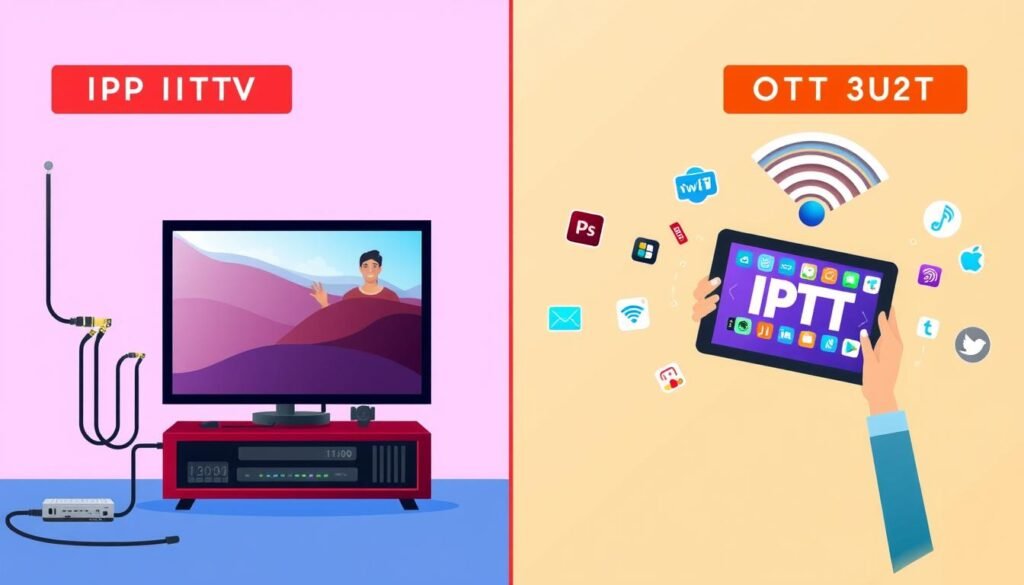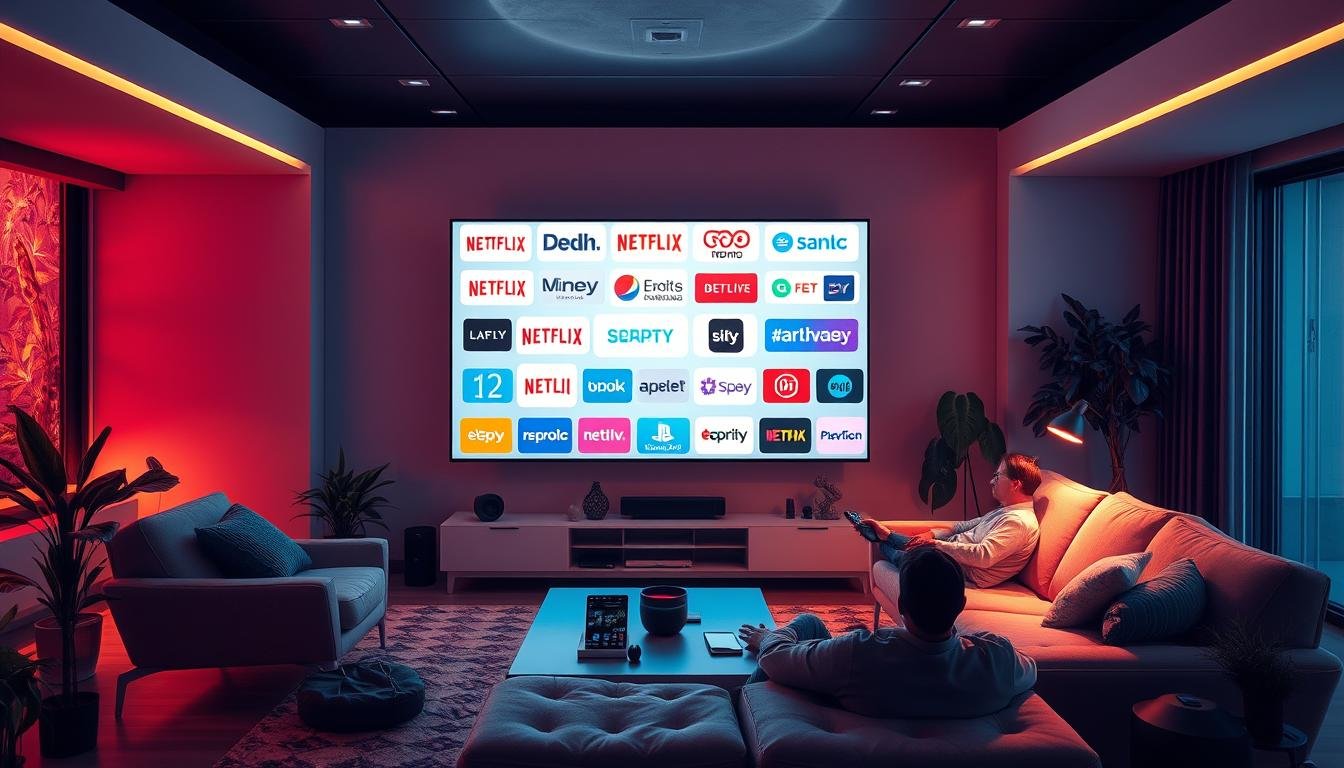The world of digital entertainment is changing fast. The battle between Internet Protocol Television (IPTV) and Over-the-Top (OTT) media services is getting fiercer. Both offer a wide range of video streaming services. But, which one will be the top choice for viewers in 2025?
In this detailed article, we’ll look closely at IPTV and OTT. We’ll explore their main differences, how they’ve evolved, and what will shape their future. By the end, you’ll know which platform is best for your entertainment needs in the coming years.
Key Takeaways
- IPTV and OTT offer different ways to stream video, each with its own pros and cons.
- The rise of these services has been driven by tech advancements and changing what people want.
- Things like streaming quality, variety of content, user experience, and cost will be key in 2025.
- How well the internet works and the infrastructure will greatly affect IPTV and OTT’s performance and reach.
- Rules and security will also play a big part in shaping the future of these platforms.
Understanding IPTV and OTT: Key Definitions
In the world of content delivery, IPTV (internet protocol television) and OTT (over-the-top media) stand out. They offer different ways to watch content. Knowing the differences is key for better viewing experiences.
What is IPTV?
IPTV delivers TV and video over a secure internet network. It’s different from traditional TV because it uses a special network. This means better quality and more features like interactive shows and on-demand content.
What is OTT?
OTT delivers content over the public internet, not through traditional channels. Services like Netflix and Amazon Prime Video use OTT. They offer a wide range of content, available on many devices.
Differences and Similarities
IPTV and OTT both aim to entertain and inform. But they work in different ways. IPTV uses a closed network for better quality and security. OTT uses the public internet for more flexibility but may face network issues.
| Feature | IPTV | OTT |
|---|---|---|
| Network | Managed, closed IP network | Public internet |
| Quality of Service | High, consistent | Dependent on network performance |
| Security | Enhanced, controlled | Potential vulnerabilities |
| Flexibility | Limited | High |
As media changes, knowing IPTV and OTT is key. It helps both consumers and businesses choose the best way to deliver content.
The Evolution of IPTV and OTT Services
The world of video entertainment is changing fast. IPTV (Internet Protocol Television) and OTT (Over-the-Top) services are leading this change. They’ve changed how we watch content. Let’s explore how these services have grown and what the future holds.
Historical Context
IPTV started in the late 1990s. It brought TV to the internet, giving viewers more control over what they watch. OTT services, like video streaming services, became popular in the 2000s. They offered a huge library of content at our fingertips.
Growth Trends in the UK
In the UK, more people are choosing digital platforms over traditional TV. The IPTV market is growing fast. It’s expected to see more subscribers and more content.
Future Projections
Experts say IPTV and OTT services will keep getting better. They’ll offer more personal and immersive experiences. New tech like 5G and AI will improve these services, meeting our changing tastes.
| Service | Projected Growth (2025) | Key Factors |
|---|---|---|
| IPTV | Substantial Increase |
|
| OTT Services | Continued Dominance |
|
The future of video entertainment is exciting. IPTV and OTT services will keep changing how we watch our favourite shows. Stay updated for more insights into this fast-changing world.
Assessing the Quality of Service: IPTV vs. OTT
The quality of service is key when picking between IPTV and OTT. IPTV and OTT have their own strengths and weaknesses. They differ in streaming quality, consistency, and reliability.
Video Quality: Which is Superior?
IPTV often has better video quality. It can match the quality of cable or satellite TV. This is because IPTV uses its own network, ensuring a clear, high-definition picture.
On the other hand, OTT services can face video quality issues. This is especially true during busy times or in areas with slow internet.
Buffering and Latency Issues
- IPTV networks work hard to reduce buffering and latency. This makes watching videos smooth and uninterrupted.
- OTT services, however, can struggle with these problems. They depend on the user’s internet and network congestion.
Consistency and Reliability
IPTV is known for its consistent and reliable service. It has fewer interruptions or outages. This is because IPTV providers control the network from start to end.
OTT Video on Demand (VoD) services can be less reliable. They rely on the public internet, which can be unstable. This can make for a less consistent viewing experience, especially during busy times.
| Feature | IPTV | OTT |
|---|---|---|
| Video Quality | Excellent | Varies |
| Buffering and Latency | Low | Higher |
| Consistency and Reliability | High | Moderate |

“IPTV provides a more controlled and optimised viewing experience, while OTT services offer greater flexibility and accessibility at the cost of potential quality trade-offs.”
Costs Involved: A Financial Perspective
Choosing between IPTV subscription and OTT platforms involves looking at the money side. We’ll explore the costs, hidden fees, and value for money of each option.
Subscription Models
IPTV services usually cost between £10 and £50 a month. They give you access to lots of channels and on-demand shows. OTT platforms, however, offer more flexible plans. You can choose from monthly, annual, or pay-per-view options, with prices changing based on what you get.
Hidden Fees and Charges
- IPTV might charge extra for renting equipment, installation, or special channels.
- OTT platforms might have hidden costs for extra features, premium content, or data use, especially for 4K streaming.
Value for Money: An Overview
Both IPTV and OTT platforms have their good points and bad points. IPTV might give you a better and more reliable service, but it’s pricier. OTT platforms offer more flexibility and content variety, but you need to watch your data and subscription costs.
In the end, whether to choose IPTV or OTT depends on what you like, how much you can spend, and how you watch TV. Doing your homework and comparing costs can help you pick the best option for you.
Content Variety: Comparing Libraries
IPTV and OTT services both have a wide range of content. But, their libraries differ in depth and breadth.
Exclusive Channels and Programmes
IPTV has many exclusive channels and programmes not found on traditional TV. These include special regional channels and big live TV events. They also offer premium Video on Demand (VoD) content. OTT platforms, however, focus more on popular on-demand content and have fewer live TV channels.
On-Demand Content Availability
- OTT services have a huge library of Video on Demand (VoD) titles. This includes new movies, classic TV shows, and documentaries.
- IPTV providers have a more selected on-demand content. This often goes alongside their wide range of live TV channels.
Live Streaming Options
| Feature | IPTV | OTT |
|---|---|---|
| Live TV Channels | Comprehensive selection of local, national, and international live TV channels | Limited selection of live TV channels, with a focus on on-demand content |
| Live Streaming Quality | Typically higher quality with lower latency due to dedicated IPTV infrastructure | Dependent on the user’s internet connection and can be more susceptible to buffering or lower quality |
In summary, IPTV and OTT services cater to different viewer needs. IPTV is great for live TV channels and exclusive content. OTT platforms are best for a wide range of on-demand content. Think about what you like to watch to choose the best option for you.
User Experience: Interface and Accessibility
The way we watch TV on multiple screens is changing. IPTV and OTT platforms are leading this change. They focus on making it easy for us to find and watch what we like. But, how they do this can make a big difference.
Ease of Navigation
IPTV has interfaces that feel like traditional TV. But, finding on-demand and personalised content can be tricky. OTT platforms, however, are known for their simple and attractive designs. They make it easy to find new shows and movies.
Device Compatibility
OTT platforms work on many devices, like phones, tablets, and smart TVs. This lets us watch our favourite shows anywhere. IPTV, however, is mostly for set-top boxes or certain TVs. This limits where we can watch.
Personalisation Features
OTT platforms are great at making things personal. They use our viewing history to suggest shows we might like. This makes watching TV feel more like having a personal guide. IPTV doesn’t offer this level of personal touch.
| Feature | IPTV | OTT Platforms |
|---|---|---|
| Navigation Ease | Channel-centric, can be complex for on-demand and personalised content | Clean, visually appealing layouts that facilitate content discovery |
| Device Compatibility | Limited to specific set-top boxes or integrated TV models | Widespread compatibility across smartphones, tablets, smart TVs, and gaming consoles |
| Personalisation | Limited personalisation options | Tailored recommendations, personalised content profiles, and cross-device synchronisation |
OTT platforms are ahead in making TV watching easy and personal. But, IPTV still has its fans. It’s all about what you prefer and how you like to watch TV.
“The user experience is the key differentiator in the IPTV vs. OTT debate. Consumers expect seamless, personalised access to content across multiple devices, and OTT platforms have the edge in this regard.”
The Role of Internet Connection and Infrastructure
Internet protocol television (IPTV) and video streaming services rely heavily on internet quality and infrastructure. The bandwidth needed for IPTV and OTT services can change a lot. Network outages can also be a big problem for users.
Bandwidth Requirements for IPTV and OTT
IPTV and OTT services need different amounts of bandwidth. IPTV usually needs a stable, high-bandwidth for the best video quality, especially in high definition or 4K. OTT services can handle some bandwidth changes better, thanks to adaptive bitrate streaming.
Impact of Network Outages
Network outages can really affect IPTV and OTT services. If the internet goes down, IPTV users might see pixelated or broken video. OTT services might struggle to keep a steady stream. This is especially annoying for those watching live events or sports.
Future Technologies and Connectivity
As technology gets better, IPTV and OTT services will change. Technologies like 5G, fibre-optic networks, and better internet are coming. They will make these services faster, more reliable, and easier to get everywhere. This could make watching videos better and open up new chances for providers.
The internet connection and infrastructure are key for IPTV and OTT services. As viewers want more, the industry must keep improving the tech behind these services. This will make sure users have a great experience in the future.
Regulatory Aspects: Legal Considerations
The world of TV and entertainment is changing fast. It’s important to know the legal rules for IPTV and OTT services in the UK. This part talks about the key rules that both users and providers need to follow in the digital world.
UK Regulations on IPTV
IPTV services in the UK follow strict rules. These include the Communications Act 2003 and the Ofcom Broadcasting Code. These rules make sure IPTV providers offer good content, are easy to use, and protect customers. Providers must get the right licenses and follow rules to legally operate in the UK.
OTT Content Regulations
OTT content rules in the UK are complex and changing. OTT services don’t need the same licenses as traditional TV, but they must follow content rules. These rules help keep viewers safe from bad or harmful content, making sure they have a good viewing experience.
Consumer Rights and Protections
- UK consumers using IPTV and OTT services have certain rights and protections, including:
- The right to clear and accurate information about the service, pricing, and contract terms.
- The ability to cancel or change their subscription within a reasonable timeframe.
- Protection against unfair or misleading marketing practices.
- Recourse for issues such as service disruptions or unsatisfactory content quality.
Knowing the rules for IPTV vs. OTT services helps consumers make better choices. It ensures their rights are looked after when using these over-the-top media platforms.
Security and Privacy Concerns
The rise in IPTV subscription and OTT platforms brings up security and privacy issues. It’s key to protect your personal info when picking a streaming service.
Data Privacy in IPTV vs. OTT
IPTV and OTT services handle data privacy differently. IPTV providers are stricter with data protection, using a closed network. OTT platforms, however, collect and share user data more widely, using the open internet.
Risks of Unauthorised Access
Both IPTV and OTT services face risks of unauthorised access. This can harm your security and privacy. IPTV subscriptions might be hacked, while OTT platforms can have account breaches and stolen credentials.
How to Safeguard Your Information
- Use strong, unique passwords for all your streaming accounts.
- Enable two-factor authentication whenever available to add an extra layer of security.
- Be cautious of public Wi-Fi networks when accessing your IPTV or OTT services.
- Keep your devices and software up-to-date to benefit from the latest security patches.
- Consider using a reputable virtual private network (VPN) to encrypt your online activities.
“Protecting your privacy and security should be a top priority when choosing an IPTV or OTT service. Take the necessary steps to safeguard your personal information and enjoy a worry-free streaming experience.”

Understanding the security and privacy of IPTV and OTT platforms helps you make a better choice. This ensures your data is safe and you can stream without worry.
Future Trends in IPTV and OTT
The world of video streaming is changing fast. IPTV and OTT are set for a big change. New tech and what people want are making it exciting for viewers in the UK.
Innovations on the Horizon
Big changes are coming to video streaming. Expect better video quality and easier device use. AI and machine learning will make watching shows more personal.
Predictions for Consumer Preferences
- More people will choose streaming over traditional TV.
- They want content that fits their tastes.
- Live sports, news, and events will be more popular.
The Role of AI and Machine Learning
AI and machine learning are key for IPTV and OTT. They’ll make recommendations better and ads more relevant. Virtual assistants will let you control services with your voice.
UK viewers can expect a future with more choice and ease. IPTV and OTT will change how we watch our favourite shows. It’s going to be a more personal and exciting experience.
Conclusion: Making the Right Choice for 2025
Looking ahead to 2025, choosing between IPTV and OTT services is key for UK viewers. We’ve looked at the main differences, benefits, and things to think about for these streaming options. Now, let’s sum up the main points and offer advice to help you pick the best for your viewing.
Summary of Key Points
IPTV and OTT have their own special features and perks. IPTV gives a more stable and high-quality viewing experience. On the other hand, OTT has more variety and flexibility. Costs, rules, and security are also important to think about when deciding.
Final Considerations for Consumers
When picking between IPTV and OTT for 2025, think about what matters most to you. Is it video quality, variety of content, or saving money? Check your internet setup to make sure it can handle the service you choose. Also, look into the provider’s reputation, customer service, and UK rules to ensure a good experience.
Future Outlook on Viewing Habits
The world of video streaming is changing fast, with new tech and changing tastes. As we get closer to 2025, IPTV and OTT will likely mix more, with new features and services. Keep up with the latest, explore your choices, and pick what fits your entertainment needs best.

